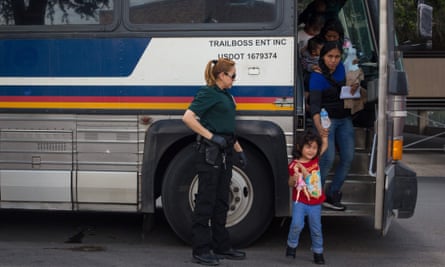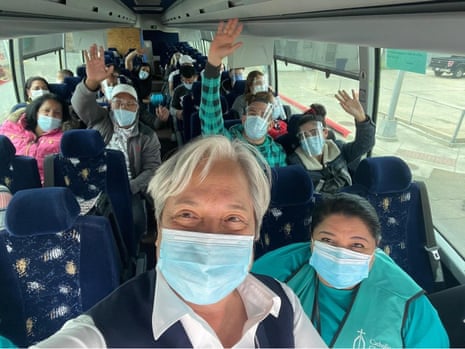Grabbing the selfie was Sister Norma Pimentel, head of the Catholic Charities of the Rio Grande Valley and the woman I call the Mother Teresa of south Texas. For the half-dozen years that I have known Sister Norma, she has been ministering to the needs of migrants on both sides of the US-Mexico border. She’s known as the pope’s favorite nun after he once publicly declared that he loved her for her efforts with migrants.
In the photo, Sister Norma is celebrating with a bus full of migrants who have lived a harrowing existence for the past several years as part of a Trump-era immigration policy called the Migrant Protection Protocols, more popularly known as the Remain in Mexico policy. It was controversial, perhaps illegal and effective as hell at tamping down the kind of bad political press that now plagues President Biden in the infancy of his administration.
For months, these migrants from the “Northern Triangle” countries of Guatemala, El Salvador and Honduras – most fleeing threats of violence from their home countries and seeking refugee status in the United States – have been living in makeshift tents in the border city of Matamoros, Mexico, across from Brownsville, Texas. They bathed in the filthy Rio Grande and endured the potential for kidnappings from Mexican drug cartels, inclement weather and the wrath of an administration intent on keeping them out only to be welcomed by a new administration set on conveying a humanitarian contrast with its predecessor.
Is there a migrant surge? Yeah. Is it a crisis? In more ways than one. Are people taking advantage of these migrants? Absolutely; none more than the fine people of the United States. These migrants personify the complexity of the immigration issue and the nuance of immigration law in this country.
They also represent a new pattern of migration that the US border patrol is ill-equipped to handle. For decades, the border patrol (La Migra, as they are known in local parlance) has built a border security mechanism aimed at stopping men who migrate from Mexico for economic reasons. These immigrants cross illegally into the United States, trying to avoid detection and look for work in big cities so they can send the money home to Mexico. Often, they return to Mexico for Christmas and other holidays only to repeat the pattern of entering the United States illegally to return to jobs.
Beginning in 2014, during the Obama administration, however, things began to change. Suddenly Mexican laborers were being outnumbered by families fleeing gang violence and economic woes in the three Central American countries south of Mexico. Taking advantage of asylum laws, these families were doing the opposite of the Mexican laborers: as soon as they crossed into the United States, they were turning themselves in to border patrol agents – often dozens of them at a time.
Soon, holding facilities were overloaded. Then came a wave of unaccompanied minors, a new challenge for border patrol agents who legally could not detain them for more than 72 hours under a court agreement made during the Clinton administration.
Sister Norma began ministering to these migrants after immigration officials started releasing families seeking asylum into the streets near a downtown McAllen, Texas, bus station. A nearby Catholic church began wondering why these families – often dirty, lost and hungry – were suddenly appearing on the streets near the bus station. Sister Norma and her Catholic Charities organization gave them a temporary place to rest, to eat, to bathe and to understand the US transportation system.
That is, until former President Trump, riding anti-immigrant sentiment into the White House, put a stop to that and created a national backlash as families began to be separated and the rare sight of refugee camps began to line the southern border in Mexico. Biden reversed all that in short order in a policy that many claim is short-sighted.

Are the streets of south Texas now being overrun by marauding invaders as conservative media and calculating Republicans declare? No. And yes. And there’s the rub: migrants from the south are an integral part of the fabric of any border community. Most came here legally; many did not. Almost all are accepted by my community – and, unknowingly, by the US community as well.
I can guarantee you that the political fallout that Biden is receiving with this increase in migrants would be nothing compared with the economic fallout if we as a country were forced to pay farm workers minimum wage.
The point is, we are all complicit. We can continue pointing fingers at one another or we can admit that if we want to continue paying reasonable prices for the ingredients to bake a cake and eat it too, we must accept that migrants will always be part of the equation.
To get there, I am hoping to share some life experiences. I was born in El Paso, next to the Mexican border town of Juárez. I now live in McAllen, next to the Mexican border town of Reynosa. Like all border communities, there are similarities in a binational existence. They are similarities that might make the roughly 1,200 miles of Texas that border Mexico as foreign to people in the United States as the rest of Latin America.
But I am a US citizen three generations removed. And I’m proud of my border heritage. I’ve spent time in Colorado, Arizona, Louisiana, Maryland, Virginia and Washington DC, and have encountered immigrants, both legal and not, in each of these communities.
My aim is to give context to the border and extend that context to the state of Texas. As one former Washington colleague recently told me: “It’s like you live on another planet.” And it’s from that perspective that I hope to explore with you, knowing that the perception exists that the border, and Texas itself, is a foreign land, the kind of land where a Catholic nun delights in taking a selfie in a bus filled with migrants from several war-torn and violence-plagued countries. And all manage smiles.
Carlos Sanchez is director of public affairs for Hidalgo county, Texas. He was a journalist for 37 years and has worked at the Washington Post and Texas Monthly magazine, as well as eight other newsrooms
